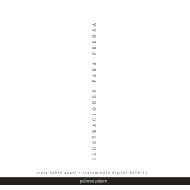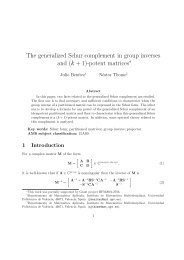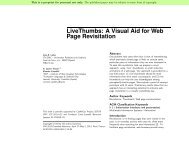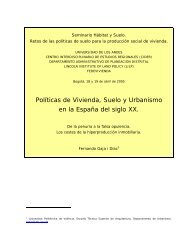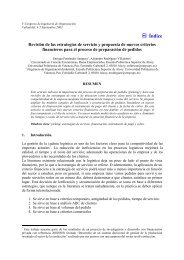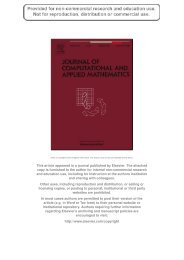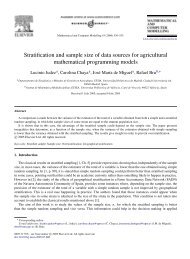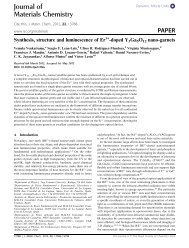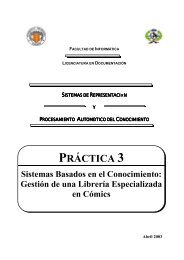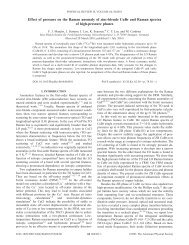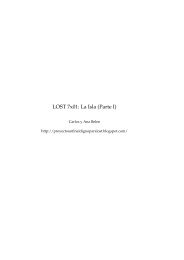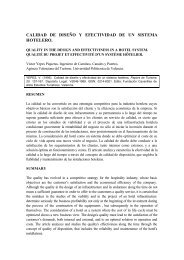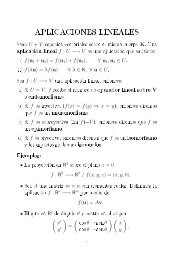Introduction to the resistivity surveying method. The resistivity of ...
Introduction to the resistivity surveying method. The resistivity of ...
Introduction to the resistivity surveying method. The resistivity of ...
Create successful ePaper yourself
Turn your PDF publications into a flip-book with our unique Google optimized e-Paper software.
11<br />
function basically tells us <strong>the</strong> degree <strong>to</strong> which a change in <strong>the</strong> <strong>resistivity</strong> <strong>of</strong> a section <strong>of</strong> <strong>the</strong><br />
subsurface will influence <strong>the</strong> potential measured by <strong>the</strong> array. <strong>The</strong> higher <strong>the</strong> value <strong>of</strong> <strong>the</strong><br />
sensitivity function, <strong>the</strong> greater is <strong>the</strong> influence <strong>of</strong> <strong>the</strong> subsurface region on <strong>the</strong> measurement.<br />
Note that for all <strong>the</strong> three arrays, <strong>the</strong> highest sensitivity values are found near <strong>the</strong> electrodes.<br />
At larger distances from <strong>the</strong> electrodes, <strong>the</strong> con<strong>to</strong>ur patterns are different for <strong>the</strong> different<br />
arrays. <strong>The</strong> difference in <strong>the</strong> con<strong>to</strong>ur pattern in <strong>the</strong> sensitivity function plot helps <strong>to</strong> explain<br />
<strong>the</strong> response <strong>of</strong> <strong>the</strong> different arrays <strong>to</strong> different types <strong>of</strong> structures.<br />
Table 2 gives <strong>the</strong> median depth <strong>of</strong> investigation for <strong>the</strong> different arrays. <strong>The</strong> median<br />
depth <strong>of</strong> investigation gives an idea <strong>of</strong> <strong>the</strong> depth <strong>to</strong> which we can map with a particular array.<br />
<strong>The</strong> median depth values are determined by integrating <strong>the</strong> sensitivity function with depth.<br />
Please refer <strong>to</strong> <strong>the</strong> paper by Edwards (1977) listed in <strong>the</strong> Reference section for <strong>the</strong> details. In<br />
layman's terms, <strong>the</strong> upper section <strong>of</strong> <strong>the</strong> earth above <strong>the</strong> "median depth <strong>of</strong> investigation" has<br />
<strong>the</strong> same influence on <strong>the</strong> measured potential as <strong>the</strong> lower section. This tells us roughly how<br />
deep we can see with an array. This depth does not depend on <strong>the</strong> measured apparent<br />
<strong>resistivity</strong> or <strong>the</strong> <strong>resistivity</strong> <strong>of</strong> <strong>the</strong> homogeneous earth model. It should be noted that <strong>the</strong><br />
depths are strictly only valid for a homogeneous earth model, but <strong>the</strong>y are probably good<br />
enough for planning field surveys. If <strong>the</strong>re are large <strong>resistivity</strong> contrasts near <strong>the</strong> surface, <strong>the</strong><br />
actual depth <strong>of</strong> investigation could be somewhat different. For example, it has been observed<br />
that a large low <strong>resistivity</strong> body near <strong>the</strong> surface tends <strong>to</strong> create a “shadow zone” below it<br />
where it is more difficult <strong>to</strong> accurately determine <strong>the</strong> <strong>resistivity</strong> values.<br />
To determine <strong>the</strong> maximum depth mapped by a particular survey, multiply <strong>the</strong><br />
maximum “a” electrode spacing, or maximum array length “L“, by <strong>the</strong> appropriate depth<br />
fac<strong>to</strong>r given in Table 2. For example, if <strong>the</strong> maximum electrode “a” spacing used by <strong>the</strong><br />
Wenner array is 100 metres (or maximum L 300 metres), <strong>the</strong>n <strong>the</strong> maximum depth mapped is<br />
about 51 metres. For <strong>the</strong> dipole-dipole, pole-dipole and Wenner-Schlumberger arrays, ano<strong>the</strong>r<br />
fac<strong>to</strong>r “n” must also be taken in<strong>to</strong> consideration. For <strong>the</strong> arrays with four active electrodes<br />
(such as <strong>the</strong> dipole-dipole, Wenner and Wenner-Schlumberger arrays), it is probably easier <strong>to</strong><br />
use <strong>the</strong> <strong>to</strong>tal array length “L”. As an example, if a dipole-dipole survey uses a maximum<br />
value <strong>of</strong> 10 metres for “a” and a corresponding maximum value <strong>of</strong> 6 for n, <strong>the</strong>n <strong>the</strong> maximum<br />
“L” value is 80 metres. This gives a maximum depth <strong>of</strong> investigation <strong>of</strong> 80x0.216 or about 17<br />
metres.<br />
Table 2 also includes <strong>the</strong> geometric fac<strong>to</strong>r for <strong>the</strong> various arrays for an "a" spacing <strong>of</strong><br />
1.0 metre. <strong>The</strong> inverse <strong>of</strong> <strong>the</strong> geometric fac<strong>to</strong>r gives an indication <strong>of</strong> <strong>the</strong> voltage that would be<br />
measured between <strong>the</strong> P1 and P2 potential electrodes. <strong>The</strong> ratio <strong>of</strong> this potential compared <strong>to</strong><br />
<strong>the</strong> Wenner alpha array is also given, for example a value <strong>of</strong> 0.01 means that <strong>the</strong> potential is<br />
1% <strong>of</strong> <strong>the</strong> potential measured by <strong>the</strong> Wenner alpha array with <strong>the</strong> same "a" spacing.<br />
2.5.1 Wenner array<br />
This is a robust array that was popularized by <strong>the</strong> pioneering work carried by <strong>The</strong><br />
University <strong>of</strong> Birmingham research group (Griffiths and Turnbull 1985; Griffiths, Turnbull<br />
and Olayinka 1990). Many <strong>of</strong> <strong>the</strong> early 2-D surveys were carried out with this array. In Figure<br />
8a, <strong>the</strong> sensitivity plot for <strong>the</strong> Wenner array has almost horizontal con<strong>to</strong>urs beneath <strong>the</strong> centre<br />
<strong>of</strong> <strong>the</strong> array. Because <strong>of</strong> this property, <strong>the</strong> Wenner array is relatively sensitive <strong>to</strong> vertical<br />
changes in <strong>the</strong> subsurface <strong>resistivity</strong> below <strong>the</strong> centre <strong>of</strong> <strong>the</strong> array. However, it is less<br />
sensitive <strong>to</strong> horizontal changes in <strong>the</strong> subsurface <strong>resistivity</strong>. In general, <strong>the</strong> Wenner is good in<br />
resolving vertical changes (i.e. horizontal structures), but relatively poor in detecting<br />
horizontal changes (i.e. narrow vertical structures). In Table 2, we see that for <strong>the</strong> Wenner<br />
array, <strong>the</strong> median depth <strong>of</strong> investigation is approximately 0.5 times <strong>the</strong> “a” spacing used.<br />
Compared <strong>to</strong> o<strong>the</strong>r arrays, <strong>the</strong> Wenner array has a moderate depth <strong>of</strong> investigation. <strong>The</strong> signal<br />
Copyright (1999-2001) M.H.Loke



